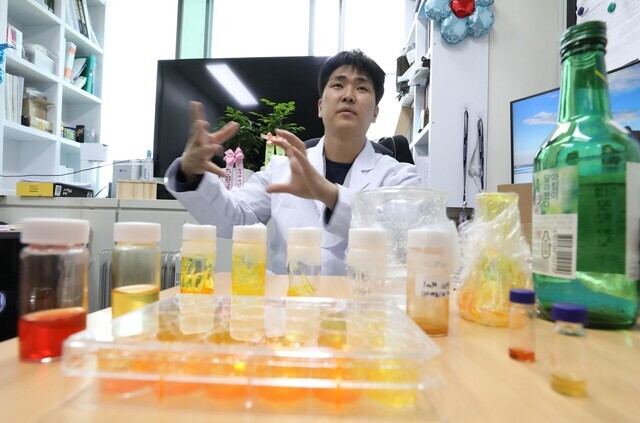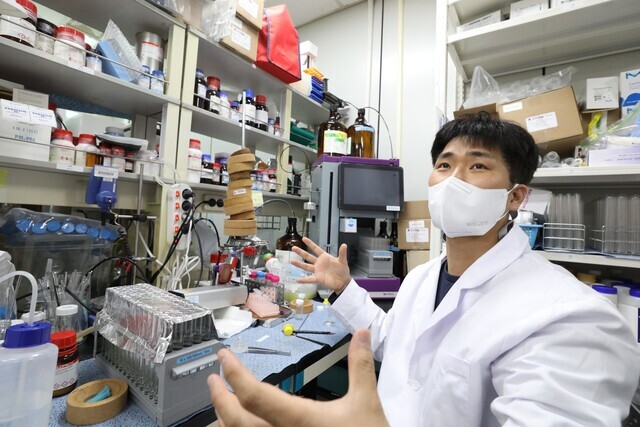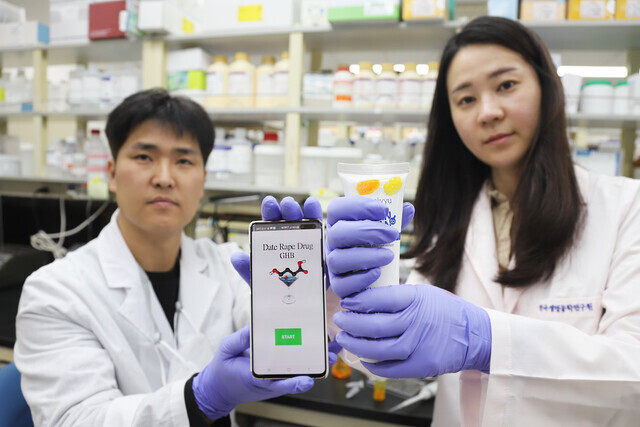hankyoreh
Links to other country sites 다른 나라 사이트 링크
Korean scientists develop gel that detects GHB, the “date rape” drug

“I went to a nightclub for the first time in my life for research purposes. I needed to know in what kind of environment the drug is used.”
This was what 43-year-old Kwon Oh-seok, a senior researcher at the Korea Research Institute of Bioscience and Biotechnology’s Infectious Disease Research Center, said with an awkward smile during a Tuesday interview with the Hankyoreh at his workplace in the Yuseong District of Daejeon.
The joint research team of Kwon and Kim Woo-geun, a senior researcher at the Korea Institute of Toxicology’s department of predictive toxicology research, successfully developed a compound that changes color when it comes into contact with GHB (Gamma Hydroxybutyrate), a drug frequently abused in sex crimes popularly known in Korea as “mulppong.” Previously, victims of sex crimes were oftentimes exposed to GHB without their knowledge, but now, anyone can easily detect the “date rape” drug in a matter of minutes.
“The big problem is that due to how [GHB] works, victims have a hard time proving that they were drugged,” said Kwon, who serves as the principal researcher of the team, as to why he embarked on his research.
“I was shocked to learn from the Burning Sun incident that [GHB] is commonly used in crimes in Korea,” Kwon said, referring to a high-profile sex scandal in Korea, adding that he wants to help catch those who abuse the drug for criminal purposes.
A central nervous system depressant with no color, smell, or taste, GHB causes one’s body to relax and leads to hallucinations and arousal within 15 minutes of entering one’s system, which is why it’s commonly abused in sex crimes. The substance can cause short-term memory loss and leaves one’s system for the most part within six hours of intake.
It’s rare for victims to be aware that they’ve been drugged with GHB, but even when they report their cases after regaining consciousness, sample collection generally proves futile, as the substance is typically already out of their systems. According to data Democratic Party lawmaker Shin Hyun-young received from the National Forensic Service (NFS), GHB was detected in only 1 case out of the 8,795 drug tests requested to the NFS by victims of sex crimes from 2017 to 2021.
After hundreds of experiments, the research team led by Kwon successfully developed a compound that changes color when it comes into contact with GHB by using a dye called hemicyanine. It’s a significant achievement, as anyone can use the color-changing compound to detect GHB in their drinks. Existing technologies for GHB detection were largely inaccessible to the public.
Kwon said, “We thought of the actual people who could be harmed [by GHB] rather than experts in scientific research,” explaining that the compound has been perfected for easy use in everyday life. He continued, “At first, we made it as a powder, but then we switched courses and made it into a gel. It’s quite viscous, so you can easily apply it to personal belongings like makeup products or credit cards, or even on your fingernails. If you drop a little bit of [GHB] on it, the yellow gel turns red within minutes.”

Throughout his research, Kwon viewed matters from the perspective of the victims. In order to gain a better understanding of the very place abuses of GHB for sex crimes take place, he even went to a nightclub for the first time in his life.
“I didn’t think I would be allowed into a club, so I went to a nightclub. It was so dark inside, which made me think that it might be hard to notice the gel turning red with the naked eye [in such an environment].”
Thanks to Kwon’s observation, an application that can detect color changes even in an environment with minimal light was developed. Users can take a photo of their gel with the app, which can detect color changes that may escape the human eye.
Kwon added, “We can even make [GHB-detecting] textile, so it’s possible to apply the recent technology to manufacturing face masks or bracelets as well. Though protecting personal information may become an issue, it’s theoretically possible to make it so that once your bracelet changes color and you take a photo of it with the app, the police are immediately notified.”
The research team is dedicated to preventing GHB-related harm to the very end. According to data made public by Shin, the Korea Customs Service uncovered 28,800 grams of smuggled GHB last year alone — an amount 61 times that of smuggled GHB uncovered in 2020, which was 469 grams. Considering that criminals typically drop 2 grams, or half a spoon, of the substance into the alcoholic drinks of unsuspecting victims, 28,800 grams of GHB can be considered enough to drug 14,400 individuals.
The technology Kwon’s research team developed has been transferred to a company and is being prepared for commercialization after the end of next year. Kwon said, “If it actually becomes available for sale, I think it should be sold at affordable prices so a lot of people can easily access it.”
“Illicit drugs and detection technologies are like spears and shields. No matter how many spears we make, manufacturers of illicit drugs will make new shields using new synthetic methods. It’s an endless war. But for the sake of victims who may be exposed to crimes, we will go the full distance. So that they may not be afraid. Everyone will be able to viscerally feel why science is necessary,” Kwon said.

By Yi Ju-been, staff reporter
Please direct questions or comments to [english@hani.co.kr]

Editorial・opinion
![[Editorial] Seoul failed to use diplomacy with Moscow — now it’s resorting to threats [Editorial] Seoul failed to use diplomacy with Moscow — now it’s resorting to threats](https://flexible.img.hani.co.kr/flexible/normal/500/300/imgdb/original/2024/0624/8217192182656295.jpg) [Editorial] Seoul failed to use diplomacy with Moscow — now it’s resorting to threats
[Editorial] Seoul failed to use diplomacy with Moscow — now it’s resorting to threats![[Column] Balloons, drones, wiretapping… Yongsan’s got it all! [Column] Balloons, drones, wiretapping… Yongsan’s got it all!](https://flexible.img.hani.co.kr/flexible/normal/500/300/imgdb/original/2024/0623/9117191084517636.jpg) [Column] Balloons, drones, wiretapping… Yongsan’s got it all!
[Column] Balloons, drones, wiretapping… Yongsan’s got it all!- [Editorial] It’s time for us all to rethink our approach to North Korea
- [Column] Why empty gestures matter more than ever
- [Editorial] Seoul’s part in N. Korea, Russia upgrading ties to a ‘strategic partnership’
- [Column] The tragedy of Korea’s perpetually self-sabotaging diplomacy with Japan
- [Column] Moon Jae-in’s defense doublethink
- [Column] S. Korea-China cooperation still has a long way to go
- [Editorial] Seoul must use tact and diplomacy to check deepening Russia-NK ties
- [Editorial] Thorough audit, evaluation of oil test drilling are needed
Most viewed articles
- 1Enough trash-slinging — it’s time to pursue ‘strategic communication’
- 2[Editorial] Seoul failed to use diplomacy with Moscow — now it’s resorting to threats
- 3[Column] Balloons, drones, wiretapping… Yongsan’s got it all!
- 4Han says he’ll seek special counsel bill on Marine’s death if elected PPP chief
- 5After Putin’s Pyongyang summit, Seoul and Moscow play dangerous game
- 6[Editorial] It’s time for us all to rethink our approach to North Korea
- 7Is Korea ready to protect the rights of Filipino domestic workers arriving this fall?
- 8Russia might provide military tech assistance to N. Korea if S. Korea crosses red lines, says expert
- 9Seoul hints at lethal weapons aid to Ukraine to put pressure on Russia
- 10US nuclear-powered carrier arrives in Busan for drills with South Korea, Japan